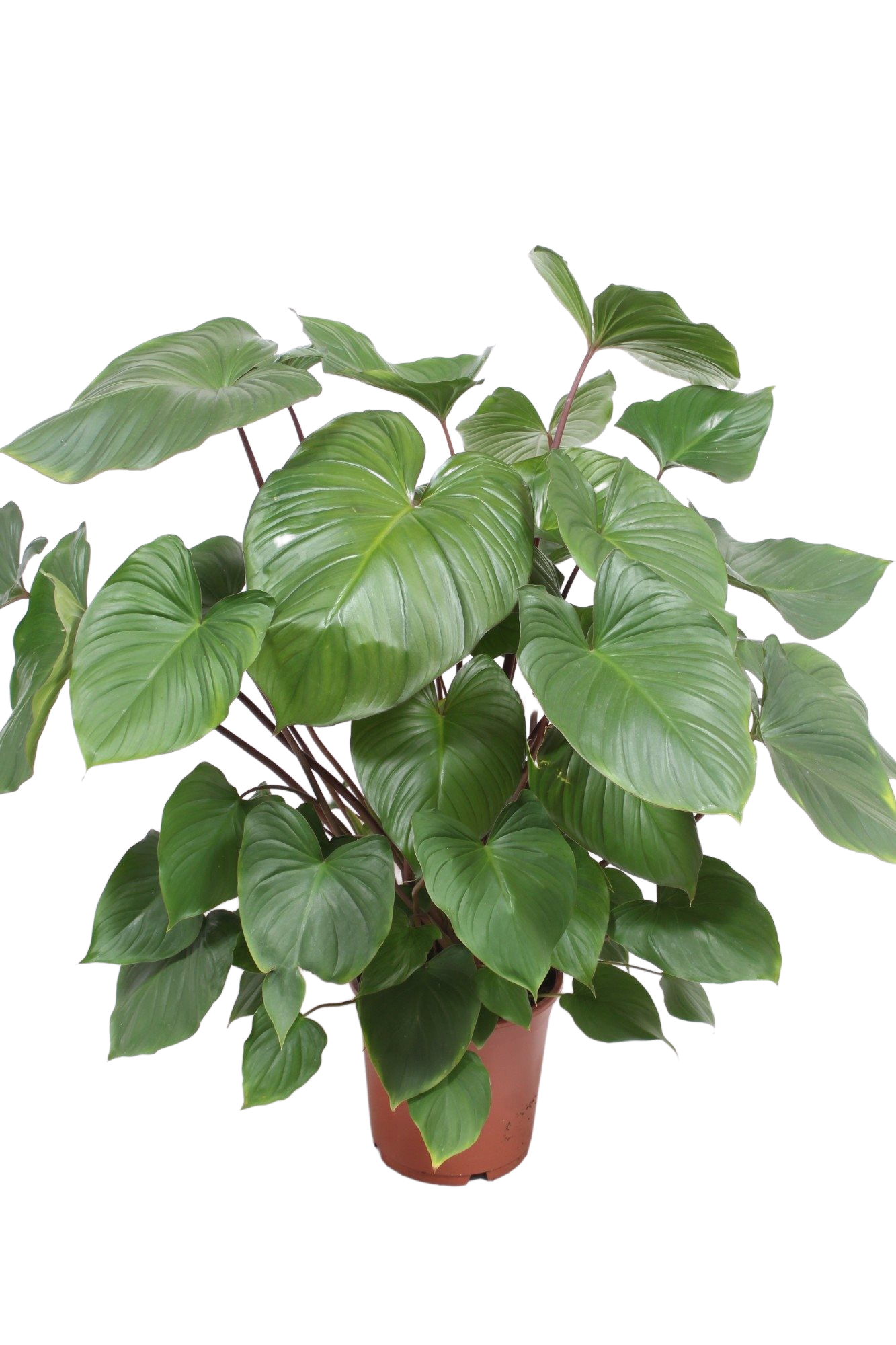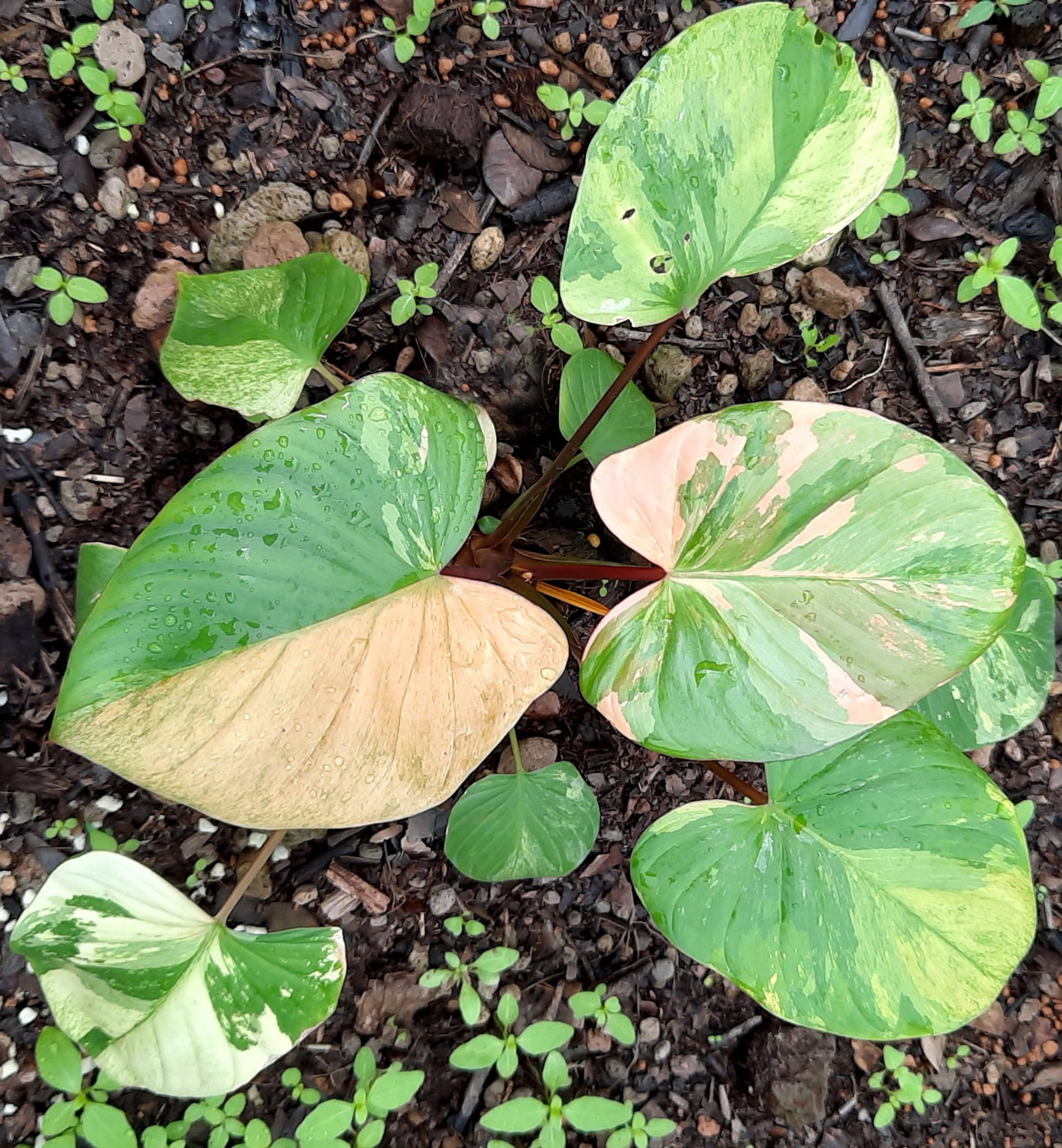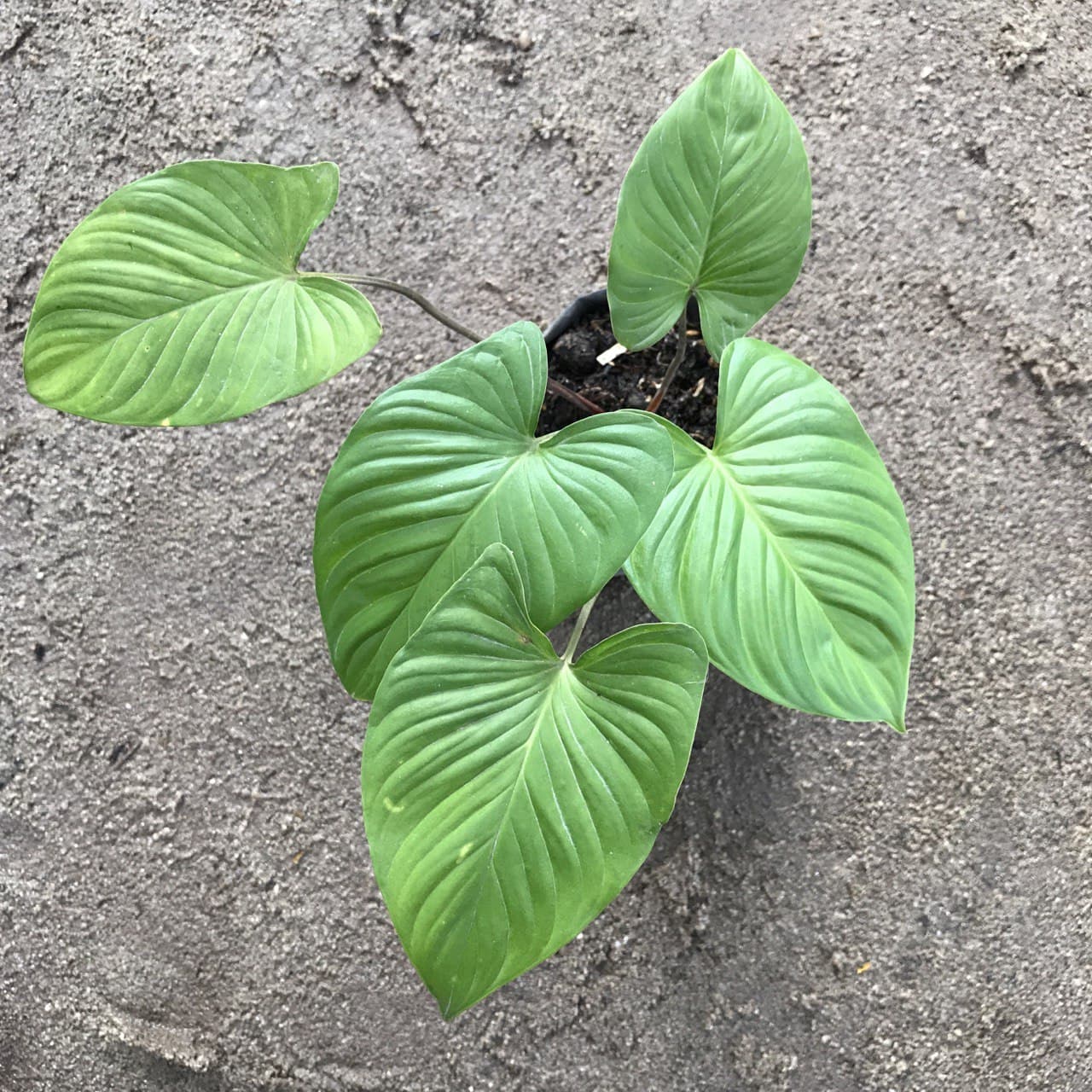A red heart. That’s a handy mnemonic to recognize the Homalomena. Of course there are no hearts on the plant, but the stem is red and the green leaves are heart-shaped and large in size. It originates from Asia and therefore loves high humidity. This and much more about the care of Homalomena can be found on this page.
Table of Contents
Homalomena names and definitions
Originating in Asia, in recent years the Homalomena has been on the rise as a houseplant. In its natural habitat, there are many species, but as houseplant there is only one that we mostly encounter: the Homalomena Rubescens, and then more specifically the Homalomena Rubescens Maggy.
On this page you will find mainly information about this Homalomena Rubescens Maggy. If you have managed to get hold of another species, then you can use the same tips for care that you read here.
Homalomena care
Watering the Homalomena
Watering the pot is important: the soil should always be slightly moist. But that doesn’t mean you should continuously give her half a watering can of water. All in all, this plant is pretty narrow. You have to know very well what you are doing. One of the things that can help you make the right decisions is a moisture meter. On it you can read how much water you still need to give. Once a week and once every two weeks in winter is usually sufficient.
Make sure the soil is always slightly moist, but never soaking wet. Then you are well off with the Homalomena Rubescens. You will notice when your plant is too long and too wet: you will see yellow leaves appear. You will also notice it the other way around: Your plant is hanging? Then she is thirsty.
The Homalomena likes moist air
With a Homalomena, it is not only important that you water it on time. Because the plant likes high humidity – but your house does not have that – it is best to spray the leaves regularly with a plant sprayer
Especially in winter, when the heating is on more often and the air is drier. Do that once or twice a week. Spraying the leaves will also keep pests away as an added bonus. If the plant still has enough moisture or water, you can wait a few days before watering or moisturizing again.
If you don’t spray, your Homalomena may develop brown leaves. You can carefully cut these off, but preferably avoid this. There are also houseplants that can stand dry air better. A good one is the Yucca, which can go for a long time without water.
Habitat, temperature and discoloration of leaves
The Homalomena is a plant that does best in partial shade. Therefore, do not place it in direct sunlight or in full sun. If you do, you can tell something is wrong by the discoloration of the leaves. So look closely at the colors of the leaves. If the leaves are discolored, it is usually because the plant is standing in the sun too much. Put it back in some more shade and keep it out of the draft
But not every discoloration is a reason to panic. If you see a red or purplish glow appear on its leaves, then the plant is totally happy! To keep him completely happy, make sure the ambient temperature is at least 15 degrees at night and at least 18 degrees during the day.
The Homalomena Maggy needs good nutrition, but as with many other houseplants, too much nutrition is harmful to the plant. Therefore, it is important to know how much and when to give extra nutrition. In this case, you can consider that the Homalomena is hibernating. In the spring and summer you give it some extra nutrition, in the colder months it is not necessary
In the warmer seasons it does not matter much in what form you give the food: liquid or solid, it can both. Always read very carefully on the packaging how much food you can give. And when in doubt: Give too little rather than too much. Too much nutrition in the soil can cause damage to the roots.
The pot and repotting
The culture pot of the Homalomena has holes in it. This is handy for dosing the water. If you have been too enthusiastic with watering, these holes can prevent root rot. The water simply runs out again.
If you want to move the plant to another pot, make sure that the new pot is about twenty percent larger than the previous one. This way the plant can continue to grow in peace. This should be done about every three years because the Homalomena Maggy grows quite slowly.
In order not to burden her too much with the move, it is best to do it in the spring. At that time of year the plant recovers the easiest. If the plant gets damaged during repotting, it has the best opportunity to repair itself at this time.
What type of potting soil does the Homalomena need?
The Homalomena can be put in universal potting soil as well as in a substrate. A substrate gives the plant more air: the material is inherently airier than potting soil and therefore provides more oxygen to the roots
Substrate can also absorb a lot of moisture. This ensures that the water you put in the pot is absorbed like a sponge. Subsequently, the plant can suck up water itself when it needs it. So you can assume that the moisture supply of the plant is basically in order. The plant will grow well as a result.
Pruning of a Homalomena
You do not need to speak of a real pruning for a Homalomena. It grows rather slowly anyway and will not grow exceptionally large or high. Therefore you do not really have to keep up with it.
You will notice that some brown dots appear on the leaves. You can carefully cut away the ugly or withered leaves. It’s a bit like trimming your hair: the small split ends sometimes have to be removed, but you don’t need to suggest a completely new hairdo with this plant.
The curse and blessing of a Homalomena
The Homalomena has a number of good reasons for wanting to bring it into your home. She is relatively easy to maintain and is also a trendy houseplant. You will rarely see a flower appear, because your home does not have the conditions for it to bloom. If you do see them, you will admire small flowers on the underside of the leaves. If you look closely, that is. Either way, you can admire the plant for its distinctive leaf and stem. And as an added bonus, this plant is also an excellent filter: it can remove polluting particles from the air and provide just a little more fresh air in your home.
The curse of a Homalomena
The advantages of a Homalomena are certainly there, but unfortunately this plant also has its disadvantages. She is poisonous, both to humans and animals. So it is better not to put it as an eye-catcher in the low window sill if you have small children, cats or dogs. Always put it out of reach of animals or children who might get curious. A little higher than normal, that is. This can make it difficult to find a suitable place for this plant, especially if it needs to be in a larger pot. Watering it can also be a little trickier. Fortunately, there are plenty of options besides the Homalomena, such as the non-toxic Peperomia, but also the Pancake plant is suitable for pets.
The Homalomena is known to be sensitive to pests, such as spider mites. Unfortunately, this is harmful. Spider mites suck what the plant itself needs to stay fit. Spider mites are very small and therefore difficult to see, but as a plant lover you probably know what to look for: unwanted dots. If you see small, brown dots the size of pinheads on the leaves, it’s time to call in the pesticide.
The best time to control spider mites on Homalomena
Homalomena needs to get rid of spider mites as soon as possible. The only problem is that these insects reproduce very quickly. Sometimes fighting the beast therefore feels like mopping the floor with the tap on. It is therefore useful to know that the eggs of this mite hatch in the evening. If you then go to work with the pesticide you can best graze them. Lowering the temperature and increasing humidity is also a good tactic to make it harder for these critters to survive.
Frequently asked questions and problems
My Homalomena gets yellow leaves
Yellow leaves are a common problem with these plants. The reason is overwatering. When the roots are in too wet soil for too long they start to rot. Thus, the roots are no longer able to transport nutrition to the leaves, and thus they turn yellow.This problem is common in houseplants such as the Philodendron and Alocasia. Therefore, always ensure proper drainage and never overwater.
What are the drops on the leaf?
Do you see a drop on your Homalomena Maggy? That’s no reason to panic. Those droplets are caused by a temporary surplus of moisture in the plant. She sweats it out, as it were, through the leaves. This is called guttation and is often seen in tropical plants such as the grass lily and the Monstera.
Is the Homalomena poisonous?
Unfortunately, this plant family, including the popular Homalomena Rubescens Maggy, is toxic to both humans and animals.
Other species of Homalomena
As written above, the most popular species at the moment is the Homalomena Rubescens Maggy. In addition, many other species exist in nature. A small number of them are (limited) available as houseplants. You see these mainly in the specialized plant stores. Examples are Homalomena Wallisii, the Homalomena Lemon Lime, the Homalomena Occulta and the Homalomena Variegata.
How big does the Homalomena get?
That depends on the species, of course, but the Homalomena Maggy can grow about 1.5 meters high. She reaches a width of about 1 meter. Besides the species, the growing conditions are also important for how big the plant becomes. With the care tips on this page you will certainly be able to make her grow big and beautiful.
Summary
| Botanical name | Homalomena |
| Origin | Asia |
| Demand for light | Lots of indirect light |
| Demand for water | Keep soil moist |
| Toxic? | Yes |
| Popular species | Homalomena Maggy |
FAQ
Does Homalomena need sunlight?
Light. Homalomena likes medium indirect light but can survive in lower light if you’re happy for her to grow quite slowly. No direct sun or the leaves will burn.
How big do Homalomena plants get?
about 12″ to 30″ tall
Is Homalomena a Philodendron?
Akin to one of their relatives, the Philodendron, Homalomena plants are tropic-loving plants. So the answer to “how to grow Homalomena” is pretty obvious in regard to its temperature requirements. Homalomena care as a houseplant will require an optimal temperature of between 60 and 90 degrees F.
How do you care for Homalomena?
Homalomena like to be kept slightly moist but not drenched. Allow the top 2 inches of soil to dry out before each water and be sure not to leave any water in the tray. Spritz regularly to keep the leaf tips from browning and help with humidity.
How tall does a Homalomena grow?
about 12″-30″ tall



